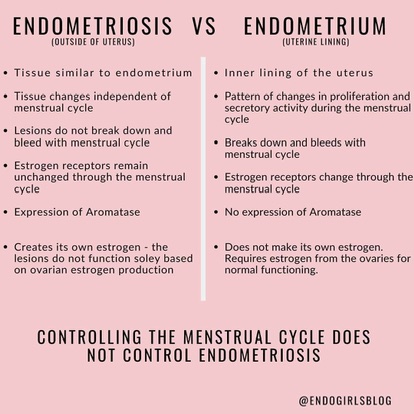Endometriosis is an autoimmune illness that one is born with. Doctors do not know what causes endometriosis – there may be several causes. So much misinformation and ignorance still exists about the origins of endo that many people spend years being dismissed, degraded, and mis-diagnosed by doctors before surgical diagnosis confirms endometriosis. People spend many more years being treated like guinea pigs because doctors cannot agree on effective medical and medicinal treatment of endometriosis.
The symptoms of endometriosis vary from person to person, but often include the following:
- Chronic pelvic pain, often extending to the lower back and/or down the legs
- Pelvic pain so bad it’s been compared to childbirth – people who have given birth say the pain of Endometriosis is worse.
- Heavy menstrual cycles
- Mittelschmerz (mid-cycle pain and/or bleeding)
- Pain during intercourse
- Moderate to severe fatigue
- Painful urination or bladder complications during menstruation
- Painful bowel movements during menstruation
- Rectal bleeding before and/or during menstruation
- Diarrhea, constipation or nausea during menstruation
- Frequent Urinary Tract Infections and/or yeast infections
- Infertility
- Low-grade fever
- Migraine headaches
- Nausea
- Dizziness
- Hypoglycemia (low blood sugar)-like symptoms
- Joint pain
- Feeling out of breath or easily winded
- Some people have NO symptoms
Stats are still all over the place as to how many people suffer with endometriosis.
(Disclaimer: Some of the quotes below have been removed from the websites over the years – I’m trying to locate where on these websites they have relocated their stats. In some cases, it’s been removed altogether)
- “Endometriosis affects at least 1 in 10 girls, women, and unmeasured numbers of two-spirit, transgender, and gender-diverse individuals. This means that almost 2 million Canadians have endometriosis.” –The Endometriosis Network Canada
- “Endometriosis, sometimes called “endo,” is a common health disease that affects 11% of American people between the ages of 15 – 44.” –Endo Black, Inc
- “Endometriosis affects approximately 190 million individuals worldwide (7.5 million in just the U.S. and 775,000 in Canada alone)” –Center for Endometriosis Care (CEC)
- “…far from being a rare disease, it’s estimated that as many as 200 million women and pubescent girls from around the world have endometriosis.” –Dr. Camran Nezhat
- “Endometriosis affects an estimated 200 million women* worldwide and approximately one in 10 women in the U.S.” –Endometriosis Foundation of America
- “Endometriosis largely affects those of reproductive age, but the disease can also be found in those who have not yet started menstruation, teens, and after menopause.” –The Endo Coalition
- “Endometriosis is estimated to affect over one million women (estimates range from 3% to 18% of women) in the United States”. –Medicine Net
- “Endometriosis affects an estimated 190 million reproductive aged women and girls worldwide.” –World Endometriosis Research Foundation (WERF)
- “Endometriosis affects an estimated 1 in 10 women during their reproductive years (ie. usually between the ages of 15 to 49), which is approximately 176 million women in the world.” –endometriosis.org
- “Endometriosis …affects at least 6.3 million women and girls in the U.S., 1 million in Canada, and millions more worldwide”. – Endometriosis Association (stat removed from site)
- “Current estimates suggest that 6% to 10% of women of reproductive age have endometriosis, or approximately 5 million women in the United States”. – National Institutes of Health (stat removed from site)
- “Endometriosis is a very common condition affecting up to 10 per cent of women between 16 and 50 years of age, often without producing any symptoms”. –NetDoctor (stat removed from site, it now says “Endometriosis is more common than you think: one in 10 women in the UK who are of a reproductive age suffer from the condition.”
- “[Endometriosis] may affect more than 11% of American women between 15 and 44.” (CAUTION, The site also contains disinformation) –WomensHealth.gov
- “Nearly 11 million women are affected by endometriosis, globally. Other sources estimate 6 to 10% of the general female population might have endometriosis.” – Wikipedia (CAUTION, the rest of the Wikipedia article is riddled with disinformation)
Treatment of endometriosis can include pain medication, surgery, hormonal treatment, and alternative medicine, but it must be noted that currently, the only definitive diagnosis of endometriosis is firstly made via laparoscopy. HOWEVER, most people with these symptoms already know they have endometriosis – you don’t need to wait for a definitive diagnosis to start asking your doctor for help TODAY!

